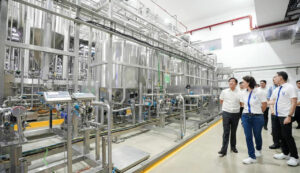




Philippines Trade Update: Trade trajectories trend along
 DOWNLOAD
DOWNLOAD

Policy Rate Updates: Double cut finale
 DOWNLOAD
DOWNLOAD

Monthly Economic Update: One for the road
 DOWNLOAD
DOWNLOAD


Manufacturing output growth picks up in December

Factory output grew at its fastest pace in three months in December, the Philippine Statistics Authority (PSA) reported on Wednesday.
Preliminary results of the PSA’s latest Monthly Integrated Survey of Selected Industries (MISSI) showed factory production, as measured by the volume of production index (VoPI), grew by 2% year on year in December, the fastest pace since 9.8% in September and picking up from 1.8% in November.
However, this was slower than the 4.5% growth posted in December 2022.
This brought the average manufacturing output growth for 2023 to 4.4%, sharply slower than the 15.4% annual average growth seen in 2022.
Analysts attributed the slowdown to supply chain disruptions due to geopolitical tensions overseas.
“Disruptions in supply chain and transportation from political tensions in Eastern Europe and the Middle East affected factory output. The Philippines is reliant on imported raw materials and work-in-progress in factory production,” Oikonomia Advisory & Research, Inc. President and Chief Economist John Paolo R. Rivera said in an e-mail.
“Relatively high inflation globally and locally in 2023 also affected production costs,” Mr. Rivera said.
Still, the manufacturing sector remained resilient last year, Philippine Chamber of Commerce and Industry (PCCI) President George T. Barcelon noted in a phone interview.
“The manufacturing sector has been holding up… We’re gradually bouncing back. We started from a lower base, and I think it’s performing quite well,” he said.
“The export sector has not been as good as what was projected but it ended up fairly well… So, construction, infrastructure, and the essentials are holding up,” he added.
The country’s trade-in-goods deficit narrowed by 9% to $52.42 billion in 2023 as exports and imports declined amid slowing demand.
Merchandise exports dropped by 7.6% to $73.52 billion last year, PSA data showed. This was a reversal of the 6.5% growth in 2022.
On a monthly basis, the manufacturing sector’s VoPI declined by 6.7% in December, a turnaround from the 3% growth in the previous month. Stripping out seasonality factors, VoPI slipped by 0.8% from the 0.7% growth in November last year.
In comparison, IHS Markit’s Philippines Manufacturing Purchasing Manager’s Index (PMI) expanded by 51.5 in December, slower than the 52.7 expansion seen in November last year. A PMI reading above 50 indicates improvement in operating conditions, while a reading below 50 shows deterioration.
The PSA said the year-on-year growth seen in December was mainly driven by the slower annual decline in the manufacture of food products at 1.4% from the 4.9% drop in the previous month.
“The manufacture of food products contributed 34.5% to the uptrend of VoPI for the manufacturing section in December 2023,” it said.
Mr. Barcelon said typhoons in the latter part of the year as well as geopolitical tensions likely led to slower food production.
“Other main contributors to the higher year-on-year growth of VoPI in December 2023 were the faster annual increase observed in the manufacture of basic pharmaceutical products and pharmaceutical preparations at 38.2% in December 2023 from 11.1% in the previous month, and the slower annual decrement in the manufacture of fabricated metal products, except machinery and equipment at 12% during the period from 23.5% annual decrease in the previous month,” the PSA added.
Of the remaining 19 industry divisions, eight posted year-on-year increases in December, led by coke and refined petroleum products (33.2% in 2023 from 20.3% in 2022), electrical equipment (25.8% from -49.9%), and transport equipment (23.4% from 6.4%).
Meanwhile, 11 industry divisions recorded annual declines.
“The highest annual drop was observed in the manufacture of wood, bamboo, cane, rattan articles, and related products at 55.3%,” the PSA said.
December’s capacity utilization rate, or the extent to which industry resources are used in producing goods, averaged 74.3%, slower than the revised 74.8% in the previous month.
“All industry divisions reported capacity utilization rates of more than 60% during the month. The top three industry divisions in terms of reported capacity utilization rate were manufacture of rubber and plastic products (80.0%), manufacture of machinery and equipment except electrical (79.8%), and manufacture of beverages (79.6%),” the PSA said.
Looking ahead, geopolitical tensions could continue to affect the manufacturing sector, analysts said.
“Sectors reliant on oil will remain affected until global tensions are eased. The government should look at alternative sources of constrained inputs,” Mr. Rivera said.
“Another thing of concern, we’re heading into El Niño where there’s less rain, and the agriculture sector might be affected. Although it goes without saying that we will still need to import more food commodities,” Mr. Barcelon added.
But expectations of slower inflation this year could boost the sector, they said.
“As inflation is easing significantly, output is expected to increase assuming no disruption, particularly from natural calamities, will happen,” Mr. Rivera said.
The Bangko Sentral ng Pilipinas expects headline inflation to average 3.7% this year, slower than the 6% print in 2023, and to ease further to 3.2% in 2025. — Bernadette Therese M. Gadon
This article originally appeared on bworldonline.com





 By BusinessWorld
By BusinessWorld